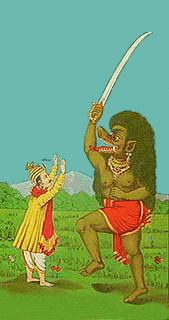Kalki Purana
The Kalki Purana (Sanskrit: कल्कि पुराण Kalki purāṇa) is a prophetic work in Sanskrit that details the life and times of Kalki, the tenth and final of the Dashavatara (the ten Avatars) of the Hindu deity Lord Vishnu. The narrative is set in the distant 4,320th century, near the end of the Kali Yuga or Dark Age, as revealed by the storyteller Suta.
The extant text comprises three aṃśas (sections) consisting 7, 7 and 21 chapters respectively.[1] Although it is considered an Upapurana or 'Lesser Purana', it is derived from passages taken directly from the 18 'Major' Puranas, including the Vishnu Purana and the Bhagavata Purana ascribed to Vyasa. It is believed that the Kalki Purana existed prior to the 16th century CE as parts of it were referenced to in the Avadhi.
Significance
As a prophetic work, the Kalki Purana writes details about events believed by Hindus to occur in the future. The work is essentially a derivation of passages collected from various Puranas describing the same subject. The work primarily describes the onset and exponential increase of evil and sin on the earth during the Kali Yuga, and the life of Kalki, who is said to bring an end to the darkness of the Kali Yuga, destroying evil and sin, and beginning a new yuga (age) of sinlessness and peace known as the Satya Yuga.
Events Depicted in the Kalki Purana
Kali Yuga

Chronologically Krishna is described as the eighth Avatar of Lord Vishnu. This happens in Dvapara Yuga. According to Kalki Purana, Kali demon will rule the earth and bring sin and misery to the people. When the first stage of the Kali Yuga begins, the varna system will deteriorate. Soon after this, the second, third, and fourth stages of the Kali Yuga begin. During the second and third portions, men will forget the name of God and no longer offer Yagna to the Devas. During the fourth portion, Canibalism will be virtually universal among the humans. To solve this problem the pious Devas will gather before Brahma for a solution. Near the end of this yuga, the Devas will then journey to Vaikunta to seek help from Lord Vishnu. Lord Vishnu will then descend to Earth to end the Kali Yuga.
Kalki Comes to Earth
Lord Vishnu comes to earth in the home of Sumati .[2] the wife of the Brahmin Vishnuyasha to reestablish Dharma on earth [3]
Life on Earth

Sri Kalki will be an avatar of Lord Vishnu the supreme Parabrahman. He will marry his eternal consort Lakshmi who is the Heavenly mother. He will then undertake the mission to complete the end of Kaliyuga and rid the world of all wicked kings and false prophets, evil people and to usher in the age of Satyuga.
Destruction of Evil
One of the main reasons Lord Vishnu would come to earth as Kalki is to destroy and defeat evil forces on earth. He would begin this with the battle, and eventual massacre, of the Sunyavadis, who have misled the people, at the city of Keekatpur. A war would later begin with the dark forces of Kali, including the demon generals Koka and Vikoka fighting against Kalki and the Devas. Koka and Vikoka would then be killed by Kalki. Thus, Kali will be defeated at the hands of Dharma, the personification of the Satya Yuga which is evil's polar opposite. Finally, Kalki will be challenged by, and intentionally accept defeat from, Raja Shashidhwaja,[4] and marry the Raja's daughter, his second wife Rama, before the start of the Satya Yuga.
Satya Yuga
After the defeat and destruction of evil on earth, the Satya Yuga (Golden Age) begins. Kalki will divide the earth into earthly kingdoms among his generals, then perform the Ashwamedha and Rajasuya sacrifices for the Devas. Sumati and Vishnuyasha, his parents, will then travel to the holy place of Badrikashram, where they will live until their death. Having finished his mission of restoring peace, Kalki will appear as Vishnu in his four-armed form, and return to Vaikuntha After the siring of Kalki's other sons Meghamaal and Balahaka, Kalki will reign on earth for 1,000 years as the king of Shambhala.
Notes
- ↑ Rocher, Ludo (1986). "The Purāṇas". In Jan Gonda (ed.). A History of Indian Literature. Vol.II, Epics and Sanskrit religious literature, Fasc.3. Wiesbaden: Otto Harrassowitz Verlag. p. 183. ISBN 3-447-02522-0.
- ↑ Prior to Kalki, Sumati gave birth to three older sons: Kavi, Praagya and Sumantra.
- ↑ The Padma Purana (6.242.8-12) states that Vishnuyasha is actually an incarnation of Svayambhuva Manu, who performed great austerities to have the Lord as his child. He received the benediction that the Lord will appear as his son three times. Thus Svayambhuva Manu appears as Dasaratha (father of Rama), Vasudeva (father of Krishna) and finally as Vishnuyasha (father of Kalki). (see here)
- ↑ . Raja Shashidhwaja, a great devotee of Vishnu, has been granted a boon by Lord Vishnu of defeating Kalki on the battlefield.
Source
- himanshu aneria, Kalki Purana, Fusion Books (1969) ISBN 81-288-0588-6
External links
| Wikimedia Commons has media related to Kalki. |
See also
| ||||||||||
